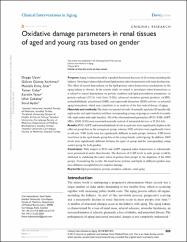Oxidative damage parameters in renal tissues of aged and young rats based on gender

View/
Access
info:eu-repo/semantics/openAccessDate
2013Author
Uzun, DuyguKorkmaz, Gülcan Güntaş
Sitar, Mustafa Erinc
Cebe, Tamer
Yanar, Karolin
Cakatay, Ufuk
Aydın, Seval
Metadata
Show full item recordAbstract
Purpose: Aging is characterized by a gradual functional decrease of all systems including the kidneys. Growing evidence links altered lipid protein redox-homeostasis with renal dysfunction. The effect of sexual dimorphism on the lipid protein redox-homeostasis mechanisms in the aging kidney is obscure. In the current study, we aimed to investigate redox homeostasis as it related to sexual dimorphism on protein oxidation and lipid peroxidation parameters, as protein carbonyl (PCO), total thiol (T-SH), advanced oxidation protein products (AOPP), malondialdehyde, glutathione (GSH), and superoxide dismutase (SOD) activity, as potential aging biomarkers, which may contribute to an analysis of the free radical theory of aging. Materials and methods: The study was carried out with 16 naturally aged rats (24 months old; eight males and eight females) and their corresponding young rat groups as controls (6 months old; eight males and eight females). All of the aforementioned parameters (PCO, T-SH, AOPP, MDA, GSH, SOD) were measured manually instead of automated devices or ELISA kits. Results: PCO, AOPP, and malondialdehyde levels in aged rats were significantly higher in the older rat group than in the younger rat group, whereas SOD activities were significantly lower in old rats. T-SH levels were not significantly different in male groups; however, T-SH levels were lower in the aged female group than in the young female control group. In addition, GSH levels were significantly different between the aged rat group and the corresponding young control group for both genders. Conclusion: With respect to PCO and AOPP, impaired redox homeostasis is substantially more prominent in males than females. The decrease of G-SH levels in male groups could be attributed to stabilizing the redox status of protein thiol groups by the depletion of the GSH groups. Considering the results, the renal tissue proteins and lipids in different genders may have different susceptibilities to oxidative damage.


















